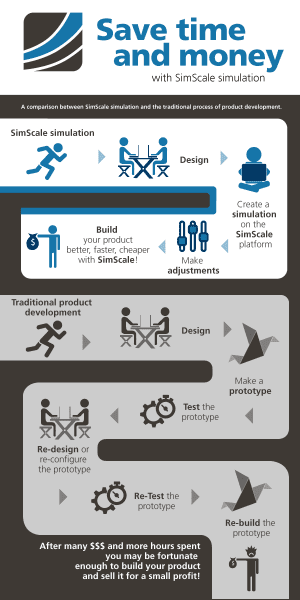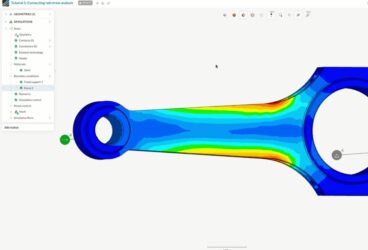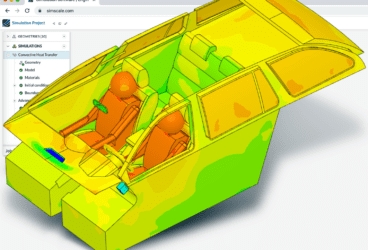Evidence from many competitive companies shows that employing simulation allows significant optimization of the design processes to deliver better products in a much shorter period of time. If you are an engineer struggling with generating support from your manager who doesn’t see the value of engineering simulation software, you are not alone.
The most commonly cited sources of skepticism when it comes to adopting simulation technology are:
- Attachment to the status quo
- Lack of understanding of the technology and its value
- High costs of software and hardware
- Difficult access to high-performance computing power
- Training and expertise barriers
Many of these reservations are justified ― while the first two can be overcome by appealing to your boss in the right way, even the most tech-savvy and open-minded manager must consider the costs of the investment and the limited resources at his disposal. The current industry standard ― on premises CAE software solutions that have been used for the past 50 years ― are indeed expensive and can be difficult to integrate into the design process of a company that has never employed simulation software before. Despite all the benefits of the technology, many managers simply do not consider it as a practical investment. To convince your boss otherwise, you need a compelling argument.
However, with the emergence of cloud-based solutions and companies like SimScale, many of these concerns have been invalidated, making simulation software accessible to anyone with a laptop and a desire to learn. You can read more on the democratization of CAE in this article: The Future of Product Design is in the Cloud.
This development has made it easier than ever to convince your manager to adopt and integrate simulation software. That said, we prepared a few arguments to help you successfully pitch the idea.
This free infographic illustrates how architects and engineers can use CFD to virtually test and optimize building designs and HVAC systems. Download it for free.
Emphasize the Benefits — Propose a Solution, Not a Tool
While SimScale has a variety of advanced features that engineers value highly, your manager needs to know what benefits the adoption of this tool would bring to the company. Focus on the “What” rather than the “How” of the problem that simulation would solve. This can be summed up in three main arguments (supported by survey results from this recent Aberdeen report):

Benefit 2: Shorter development time. Shortened product development schedules were cited by 52% of respondents in the Aberdeen report as their main reason for investing in simulation, and while many managers fear that having to learn a new tool would slow the engineers down, the numbers tell a different story. Companies report that in the early stages of integrating a simulation tool, engineers were able to cut the development time by 8% at first and 14% toward the end of the design process.
Benefit 3: Better product design. Engineering simulation is no longer a tool strictly meant for verifying product design and driving development costs down — it has become a key component of product innovation, allowing engineers to test and evaluate innovative ideas that are riskier, but have higher potential. Empowering engineers in such a way leads to higher product differentiation and contributes to overall top-line growth.
Dispel Concerns – Adopting Simulation Is Easier Than It Seems
One of the things that prevent companies benefiting from simulation technologies are the widespread misconceptions about the software. Many of them have been justified in the past but have since been rendered obsolete thanks to innovative solutions and the advancement of technologies, such as the cloud. Here’s how you can use that to counter the most commonly occurring misconceptions.
Misconception 1: The costs of using simulation software are too high. Many managers can be reasonably reluctant to invest in a tool requiring regular and costly maintenance, investment in hardware, and licenses, with a cloud-based simulation tool, those concerns no longer exist. Separate licenses for different types of analysis (CFD, FEA, Thermal etc.) are replaced by monthly or yearly subscriptions granting you access to all the features. And with a cloud-based solution, you will always have the latest version of the software in your web browser while maintenance is done automatically.
Misconception 2: Computer-aided engineering always requires specialized local hardware. While it is true that powerful simulation tools used to require considerable hardware investments, with SaaS solutions like SimScale you have access to unlimited computing capacity. A standard web browser and Internet connection are sufficient for effective and flexible setup of numerical simulations. With simulation functionality ranging from solid mechanics and fluid dynamics to thermal simulation, every user has access to state of the art simulation and computing methods — and those are just some of the many arguments in favor of cloud-based solutions.
Misconception 3: Simulation software training takes months. A common problem with many simulation tools is their complexity. While this occasionally may be necessary to perform sophisticated simulations, complicated UI and lack of readily available training materials make it impossible to extract any value from the tool without months of extensive training. To resolve this issue, we put constant effort into improving our users’ experience. SimScale is integrated with state of the art solvers including OpenFOAM, Code_Aster, YADE, and SU2. The platform was developed to provide a wide range of simulation features in a single tool. It all comes with a user-friendly interface, no shell scripts, no coding, and no difficulty. This massively reduces the expertise required to use it.
In addition, we provide our users with simulation templates, step-by-step tutorials, and webinars, as well as individual support on our forum, so you could start benefiting from our tool as soon as possible.
Ready to make a case for simulation in front of your manager? Here is a final tip for you!
While your message is key, it is your phrasing that can sometimes determine the success of your proposal. Unless your manager is a tech expert, chances are he/she might not be able to comprehend or appreciate all the technical aspects of a highly-sophisticated tool. Avoid using excessive technical language and phrase your proposal in terms that your manager would understand. Take advantage of the tool — a small demonstration using visuals generated by the software will give weight to your arguments and increase your chances of convincing your manager. Bring up the existing success stories—those companies benefited from SimScale and so can yours. Pitching to your colleagues to gain additional influence can be a good first step before proposing the idea to the management.
There is no denying that CAE has entered a democratization stage and cloud-based solutions are an easy sell to even the wariest and skeptical manager. The SimScale pricing model allows you to start with simulation for free through the Community plan or get a Professional account and scale the simulation capacity as it is needed. Give it a try!
SimScale’s CEO David Heiny tests the capabilities of the platform to solve a real-life engineering problem. Fill in the form and watch this free webinar to learn more!



